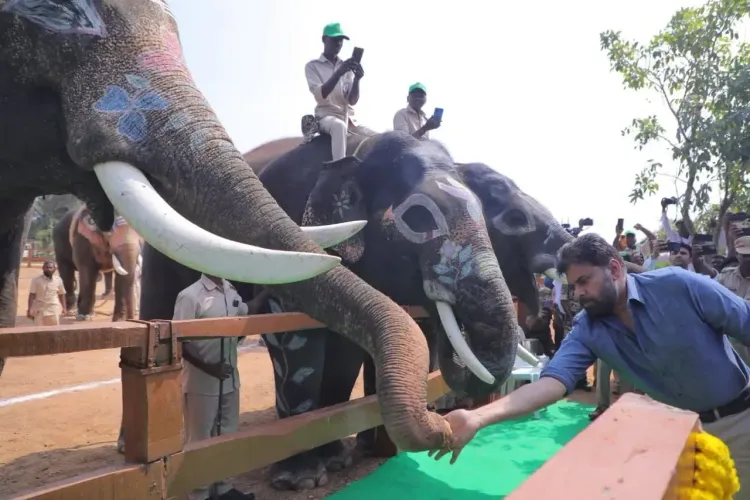Did Pawan Kalyan Just Launch the Kumki Elephant Training Centre?

Synopsis
Key Takeaways
- Kumki elephants are trained to manage wild elephant movements.
- The training centre is located in Chittoor district.
- Project HANUMAN focuses on wildlife care and rehabilitation.
- Since 2021, there have been 23 human fatalities due to elephant attacks.
- A radio collar system will help monitor elephant movements.
Chittoor (Andhra Pradesh), Nov 9 (NationPress) - On Sunday, Pawan Kalyan, the Deputy Chief Minister of Andhra Pradesh and Minister for Forest and Environment, officially launched the Kumki elephant training centre in the Chittoor district.
This expansive 20-acre facility is located in Musalimadugu village, adjacent to the Koundinya Wildlife Sanctuary in Palamaner mandal. Its primary purpose is to train Kumki elephants to monitor and control the movements of wild elephants venturing into human settlements.
In May, the state successfully relocated four Kumki elephants from Karnataka to mitigate the issue of wild elephants entering villages.
These wild elephants often migrate from neighboring Tamil Nadu and Karnataka through the Mudumalai and Bannerghatta sanctuaries, located on the edges of the Western Ghats. Their incursions into agriculture can cause significant damage to crops and pose risks to human safety.
An official statement revealed that forest officials updated the Deputy Chief Minister on the vital role Kumki elephants play in addressing the escalating human–elephant conflicts in western Chittoor and the nearby Annamayya and Tirupati districts.
Officials explained how trained Kumkis are employed to guide wild elephants back to their natural habitats and into the Koundinya sanctuary.
Pawan Kalyan learned that since 2021, elephant-related incidents have resulted in 23 human fatalities across the Kuppam, Palamaner, and Chittoor ranges. Additionally, wild elephants have caused destruction to crops across more than 4,000 acres.
During his visit, the Deputy Chief Minister toured the centre, showed a keen interest in the training processes, interacted with mahouts, and generously donated Rs 50,000 from his personal funds to support them.
He also observed the Kumkis perform various maneuvers, capturing the moments on his camera and even feeding the elephants.
Pawan Kalyan unveiled a poster for Project HANUMAN (Healing and Nurturing Units for Monitoring, Aid and Nursing of Wildlife), aimed at enhancing wildlife care, rehabilitation, and conflict management through modern veterinary support and systematic monitoring.
Officials briefed him on the 11 core components of the project, which include creating rapid response teams, wildlife rescue units, animal healthcare facilities, and awareness initiatives in forest communities.
The Deputy Chief Minister instructed officials to draft a comprehensive plan with specific goals and timelines for effective execution.
He emphasized that both the Kumki camp and Project HANUMAN are critical for wildlife protection and ensuring the safety of local populations.
Furthermore, he called for the development of a new application utilizing advanced technology to provide real-time information about animal movements to the public, with a target release date of March 3, 2026.
Kalyan encouraged collaboration among the Forest Department, Panchayat Raj, and Agriculture and Horticulture Departments to advance the HANUMAN Project. He requested a progress review by the third week of November.
He also highlighted the necessity of identifying alternative crops less appealing to elephants and persuading farmers to adopt these alternatives. Many mango orchards in Chittoor attract elephants, and he stressed the need for coordination with relevant departments to assess the impact of crop changes on farmers' incomes. He suggested exploring alternative income sources such as beekeeping and eco-tourism.
Officials confirmed they have received authorization from the central government to implement a specialized radio collar system for elephants, which will assist in tracking their movements and alerting nearby residents.










